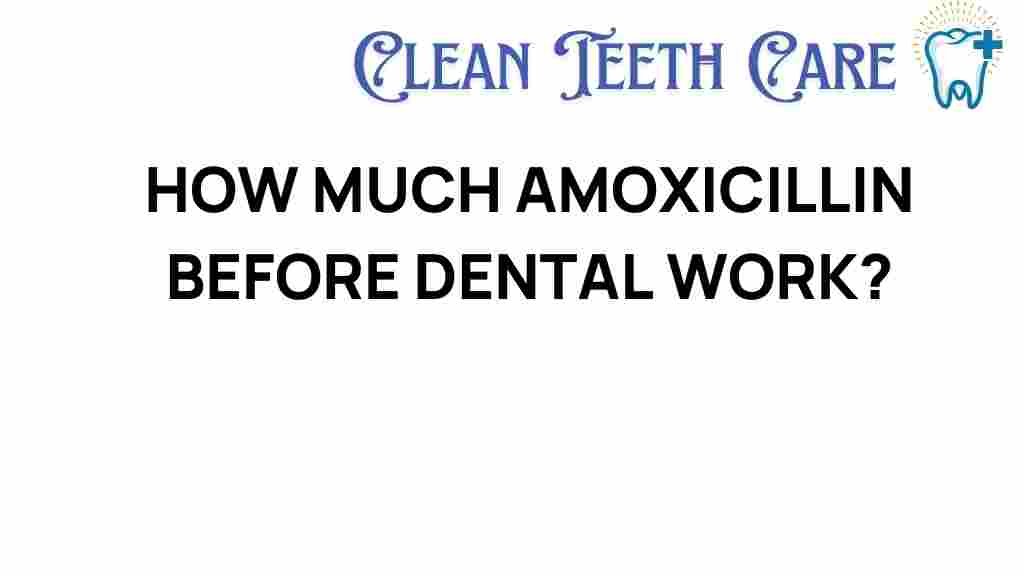How Much Amoxicillin Is Necessary Before Dental Work?
When it comes to dental procedures, ensuring patient safety and preventing infections are paramount. One of the common antibiotics prescribed before dental work is amoxicillin. This article will delve into the guidelines surrounding the use of amoxicillin for antibiotic prophylaxis, specifically before dental procedures. Understanding the dosage guidelines and the importance of infection prevention is crucial for maintaining optimal oral health.
Understanding Antibiotic Prophylaxis
Antibiotic prophylaxis refers to the preventive use of antibiotics in patients who are at risk of developing infections during dental work. Certain dental procedures can introduce bacteria into the bloodstream, particularly in individuals with specific medical conditions. This can lead to serious health complications, such as infective endocarditis.
Who Needs Antibiotic Prophylaxis?
Not everyone requires antibiotic prophylaxis before dental work. The American Dental Association (ADA) and the American Heart Association (AHA) provide guidelines to determine which patients should receive antibiotics:
- Patients with prosthetic heart valves.
- Patients with a history of infective endocarditis.
- Patients with certain congenital heart defects.
- Patients with heart transplant recipients who develop heart valve problems.
Consulting with your dentist and healthcare provider is essential to establish whether you fall into one of these categories.
The Role of Amoxicillin in Dental Procedures
Amoxicillin is a type of penicillin antibiotic that is effective against a variety of bacteria. It is commonly prescribed for prophylaxis before dental work to minimize the risk of infection. Knowing the appropriate dosage is vital for patient safety.
Dosage Guidelines for Amoxicillin
The typical dosage of amoxicillin for antibiotic prophylaxis prior to dental work varies based on the patient’s health status:
- Adults: The usual dose is 2 grams (2000 mg) taken orally, 30 to 60 minutes before the dental procedure.
- Children: The recommended dose is 50 mg/kg (up to 2 grams) taken orally, 30 to 60 minutes before the dental procedure.
It is important to note that if a patient is allergic to penicillin, alternative antibiotics such as clindamycin may be prescribed.
Step-by-Step Process for Taking Amoxicillin
Here’s a simple step-by-step process to follow if you are prescribed amoxicillin before your dental work:
- Consult Your Dentist: Have a detailed discussion about your medical history and any allergies you may have.
- Get a Prescription: If indicated, your dentist will prescribe amoxicillin or an alternative antibiotic.
- Timing: Take the medication 30 to 60 minutes before your dental appointment.
- Follow Up: If you experience any side effects or have concerns, consult your healthcare provider.
Potential Side Effects of Amoxicillin
While amoxicillin is generally well-tolerated, some patients may experience side effects. Common side effects include:
- Nausea
- Diarrhea
- Rash
- Allergic reactions (in rare cases)
If you experience severe allergic reactions such as difficulty breathing or swelling of the face or throat, seek medical help immediately.
Troubleshooting Tips
Here are some troubleshooting tips to consider when taking amoxicillin before dental work:
- Missed Dose: If you forget to take amoxicillin, take it as soon as you remember. However, if it’s almost time for your appointment, skip the missed dose and continue with your regular schedule.
- Allergic Reactions: Always inform your dentist about any known allergies to antibiotics before undergoing dental work.
- Consultation: If you have any concerns about taking amoxicillin, discuss them with your healthcare provider.
Conclusion
In conclusion, understanding how much amoxicillin is necessary before dental work is essential for infection prevention and ensuring patient safety. Following the dosage guidelines provided by health professionals can significantly reduce the risk of complications during dental procedures. If you believe you need antibiotic prophylaxis, consult with your dentist to determine the best course of action for your oral health.
For more information on dental health and procedures, visit the American Dental Association website.
This article is in the category Treatments and created by CleanTeethCare Team
